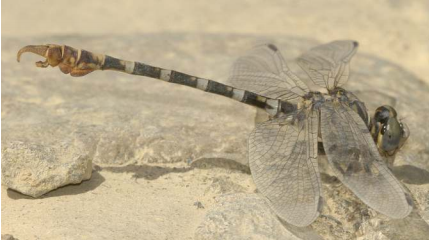Sinai Flussjungfer
© Clemens M. Brandstetter
 (from Boudot & al. 2009:138): Paragomphus sinaiticus is restricted to the Arabian Peninsula, Sinai and the Sahara. The populations in the Aïr mountains in northern Niger are isolated from the main distributional range and might represent a relict of a former pluvial period.
(from Boudot & al. 2009:138): Paragomphus sinaiticus is restricted to the Arabian Peninsula, Sinai and the Sahara. The populations in the Aïr mountains in northern Niger are isolated from the main distributional range and might represent a relict of a former pluvial period.
Bei IUCN finden wir folgende Information: "The species is known from 33 localities in a highly fragmented range with difficult access, covering part of Africa (Sudan), Arabia (Oman, Saudi Arabia, United Arab Emirates and Yemen), the Sinai in Egypt and western Iran. The overall number of records increased during the last decade due largely to an increase in resident observers in south-east Arabia, showing that at least this area is still only partly explored for species. It is expected that with increased collecting efforts new localities will be discovered in this area as well as in western Iran, where the species was recently discovered (2001-2002). New search in Niger is not possible due to the unstable situation of the country. It is likely that future field work will produce new data and localities in the Sudanese Red Sea Hills and the Sinai. At present, the global range of this species has been estimated in more than 10 locations (approximately 28) and its AOO is 132 km2 (considering a 2x2km2 grid size). Habitat destruction and drought have been observed to contribute to the continuing decline of the species' habitat quality in Africa and the Arabian Peninsula (Schneider and Boudot pers. obss.), and is affected by the decrease of rainfall and the increase of water demand due to human development in the Sahel and southern Arabia. No severe fragmentation or extreme fluctuation of the population has been confirmed. Therefore, the species qualifies for being listed Near Threatened because it meets subcriterion B2b(iii) with the information available at present. This species was previously assessed as VU A2c+3c, but the new records show an apparent broader distribution that previously known. Even though the sites from where it has been recorded are far apart and threats are known to affect local subpopulations, these are not considered to have a significant impact on the global population at present. Therefore, following a precautionary approach, the global category Near Threatened is believed to be the most adequate for this species that is probably Least Concern."
Die Sinai-Flussjungfer, Paragomphus sinaiticus (Morton 1929), kommt in einer isolierten Population im Niger vor; weiters am Sinai, in Saudi-Arabien und im Sudan. Sadeghi & al, (2009) melden die Art als neu für den Iran.

Männchen aus Al Madhah, Oman – Foto: © Keith Wilson.
Literatur:
Boudot J.-P., V. J. Kalkman, M. Amorín, T. Bogdanović, A. Rivera, G. Degabriele, J.L. Dommanget, S. Ferreira, B. Garrigós, M. Jović, M. Kotarac, W. Lopau, M. Marinov, N. Mihoković, E. Riservato, B. Samraoui & W. Schneider 2009: Atlas of the Odonata of the Mediterranean and North Africa. – Libellula Supplement 9:1-256.
Martens K. & H.J. Dumont 1983: Description of the larval stages of the desert dragonfly Paragomphus sinaiticus (Morton), with notes on the larval habitat, and a comparison with three related species (Anisoptera: Gomphidae). – Odonatologica 12: 285-296.
Morton K. J. 1929: Odonata from the Sinai peninsula, Suez and Palestina, including a new species of Mesogomphus. — Entom. monthly Mag. 65: 60 — 63
Sadeghi S. & J. Mohammadalisadeh 2009: Additions to the Odonata fauna of Iran. – Iranian Journal of Science & Technology 33: 355-359.
Schneider W. 2004: Critical species of Odonata in the Levant. – Intern. Journal of Odonatology 7 (2): 399-407.
Smith, K.G., Diop, M.D., Niane, M. & W.R.T. Darwall (Compilers) 2009: The Status and Distribution of Freshwater Biodiversity in Western Africa – Gland, Switzerland and Cambridge, UK : IUCN. x+94pp+4pp cover.
